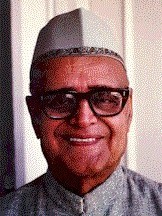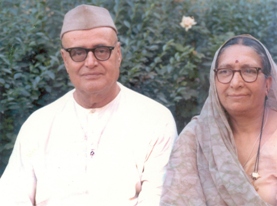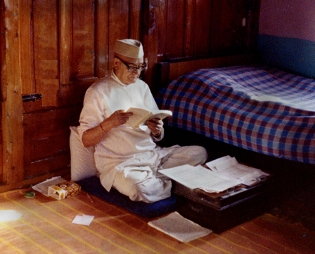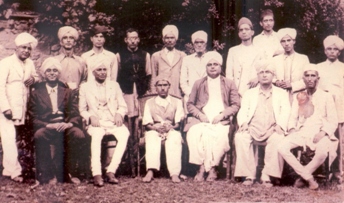Gopi Krishna and Kundalini
by Teri Degler and Michael Bradford

"Gopi Krishna was a pioneer in the land of
spirituality. His insights into the quantum
nature of the body predates the scientific
discoveries of today. I salute this great
sage and scientist of the twentieth century."
–Deepak Chopra
The ICR offers a number of books written by Gopi Krishna in our store. Your contributions are greatly appreciated and are vital in allowing ICR to continue our mission.
Gopi Krishna is widely recognized as having done more to advance our understanding of Kundalini than anyone else in modern times. He has put this amazing aspect of our nature in a logical, consistent and scientific light, and presented us with a new understanding of the goal of evolution, both as individuals and as a species.
Kundalini awakened in him quite forcefully in 1937 after 17 years of intense meditative practice. From that moment onwards, his consciousness was radically altered and over the next 12 years or so, it underwent an even more dramatic transformation to a perennial state.
It was Gopi Krishna’s belief that knowledge of Kundalini is essential for the survival of the race, and that with this knowledge we would then begin to explore aspects of creation totally hidden from our view at present.
Gopi Krishna was born in 1903, near the city of Srinagar, in the Jammu and Kashmir State in northern India. He spent his earlier years there and later, in Lahore, in the Punjab of British India. At the age of twenty, he returned to Kashmir. During the succeeding years he secured a post in the state government, married and raised a family.

With wife Bhabi
Early in his career he became the leader of a social organization that was devoted to helping the disadvantaged in his community, especially with regard to issues concerning the well-being and rights of women.
In 1967 he published his first major book in India, Kundalini—The Evolutionary Energy in Man (currently available under the title Living with Kundalini). Shortly thereafter it was published in Great Britain and the United States and has since appeared in eleven major languages. The book presented to the western world for the first time a clear and concise autobiographical account of the phenomenon of the forceful awakening of Kundalini.
Kundalini Awakening
At the age of thirty-four, while meditating one morning, he experienced the sudden and forceful awakening of Kundalini. As he sat meditating - exactly as he had for the three hours before dawn each day for seventeen years - he became aware of a powerful, pleasurable sensation at the base of his spine. He continued to meditate, and as he did, the sensation began to spread and extend upwards. It continued to expand until he heard, quite without warning, a roar like that of a waterfall and felt a stream of liquid light enter his brain. In Kundalini: The Evolutionary Energy in Man, he describes what happened:
"The illumination grew brighter and brighter, the roaring louder, I experienced a rocking sensation and then felt myself slipping out of my body, entirely enveloped in a halo of light…I felt the point of consciousness that was myself growing wider, surrounded by waves of light…I was now all consciousness, without any outline, without any idea of a corporeal appendage, without any feeling or sensation coming from the senses, immersed in a sea of light simultaneously conscious and aware of every point, spread out, as it were, in all directions without any barrier or material obstruction…bathed in light and in a state of exaltation and happiness impossible to describe."
Gopi Krishna's experience radically altered the path of his life. He came to believe that our brains were evolving and that an individual's profound mystical experience was a foretaste of what would eventually become an all-pervasive transformation in human consciousness.
In his own case, Gopi Krishna's initial experience triggered a transformative process that lasted for twelve years. During this time, the sensations of light, splendor and joy alternated with - and were often completely overshadowed by - sensations of fire, unbearable heat and bleak depression.
Being from a culture that was steeped in the yogic tradition, Gopi Krishna looked there for an explanation for what seemed to be happening to his mind and body. Immersing himself in the ancient teachings on the subject, he discovered that much of it was in symbolic and cryptic language. He learned one reason for this was that the tantric yoga masters had not wanted the knowledge to fall into the hands of those who were not fully prepared for the experience. It was believed that premature or incorrect awakening of Kundalini could cause a number of frightening symptoms, including searing lights, horrific heat, and deep depression. Some ancient yoga masters even believed that the incorrect awakening of Kundalini could cause insanity or death.

However, Gopi Krishna also discovered that the esoteric teachings contained a number of simple practices that might help bring the energy back into balance after it had been awakened incorrectly. A few of these practices, particularly those related to living a moderate life-style, helped him begin a long process of bringing the energy back into balance.
The Bloom of Genius
Over the years, the periods of suffering waxed and waned until, finally, they were replaced by the visions of light, sensations of bliss and the spontaneous development of an extraordinary level of creative ability. Before his death in 1984 at the age of eighty-one, Gopi Krishna would write seventeen books on Higher Consciousness - three of them entirely in verse. He credited this enormous output not to his own efforts but to inspiration from a higher source. This inspiration was so extraordinary that one of his books, The Shape of Events to Come – a volume of more than two hundred pages - was composed in three weeks.
Relating to the crises that still haunt the world today, Gopi Krishna made it clear that one of the main reasons the earth teeters on the brink of environmental and nuclear destruction was that the masculine and feminine are so out of balance. Of course, he was not referring here to traits held by "men" as opposed to those held by "women" but rather those characteristics associated with the masculine and feminine principles we all hold within ourselves.
Within this context, he made a forceful argument, showing how, particularly in the last two centuries in the western world, the glorification of the ideals traditionally associated with the masculine - reason, logic, power, strength, victory, territorialism - and the denigration of those related to the feminine - emotion, intuition, nurturing - had led to the proliferation of arms, the development of agents of mass destruction, the spread of war and terrorism and the systematic rape of the environment.
It is not surprising that Gopi Krishna had such a keen understanding of the importance of the feminine side of our natures. Kundalini, the cosmic force that was so active in his body is seen in the yogic tradition as feminine. Known also as kundalini-shakti, kundalini is said to operate in the microcosm of the human body in ways that parallel the way Shakti - the divine feminine principle and partner of the divine masculine principle, Shiva - operates in the macrocosm that is our Universe.
Social Activism
One of the little known facts about Gopi Krishna's life is that he was a crusader for women's rights. Putting this in historical and cultural context shows how very extraordinary his dedication to this cause was. In 1930 it had been less than ten years since women had won the vote and the vast majority of the women in the world were still considered chattel. In India conditions for women were even worse and a man campaigning publicly for women's rights would have been unheard of.
Gopi Krishna did far more than just speak out for women. He acted, and at one point ended up imprisoned for his actions. One of his most far-reaching contributions involved bettering conditions for widows. At that time in India, the plight of a woman whose husband died was often horrific, especially if she had no grown children to help or protect her. The custom of suttee (throwing oneself on the husband's funeral pyre) though outlawed was still practiced, particularly in remote areas. Even if a widow was saved from this terrible death, she and her children were often abandoned by her in-laws. If these women's own families could not care for them - and they often could not as they had already impoverished themselves paying her dowry - begging or prostitution were her only means of survival.

One of the groups that Gopi Krishna
organized to help women.
Horrified by this injustice, Gopi Krishna began a movement to save these women and children. Passionately speaking out and educating others, he soon gathered together a small band of like-minded individuals in Srinagar. Eventually they raised enough funds to build a large protective compound with small individual dwellings for each woman and her children. Over the years, he and his co-workers were also able to provide the women with equipment like sewing machines and looms and the training they needed in order to operate their own cottage industry on the premises.
Gopi Krishna also fought against the custom whereby women could not remarry. He worked to educate the public about the injustice of this custom and met with some success. A number of women under the Society's care found gentlemen they wished to marry - the women's wishes being the key. These women were protected just as they would have been by a loving family and no courtship was begun or marriage considered unless the woman explicitly desired it. When a marriage did occur the couple invariably insisted on showing their gratitude by including Gopi Krishna in the wedding party, often in the role of the father giving away the bride.
Gopi Krishna's efforts to improve conditions for women took many forms in addition to his work for widows. At one point he even staged a mock insurrection in the streets of Srinagar so that a young woman who had been sold into bondage could be rescued. Unfortunately, the police jailed him and the supporters who had caused the disruption. When the news reached the ears of the then Prime Minister, Indira Gandhi, she immediately ordered his release. After Gopi Krishna insisted that all be released, the authorities relented.
Father of the Modern Kundalini Movement
Along with all of his humanitarian efforts, Gopi Krishna produced beautiful poetry and books in prose and verse form. But his main thrust over the years was to write about mystical experience and the evolution of consciousness from a scientific point of view - that there is a biological mechanism in the human body, known from ancient times in India as Kundalini, which is responsible for creativity, genius, psychic ability, religious and mystical experience, as well as some types of aberrant mental illness.
In fact, he steadfastly resisted the ever increasing numbers of spiritual seekers who urged him to become a guru. From that day in 1937 when his awakening occurred, to the end of his life, the energy was fully active in his body, bringing about a radical and permanent transformation of his perceptive faculties. Traveling extensively in Europe and North America, he dedicated his life to promoting the scientific study of Kundalini and developing the Kundalini hypothesis which is described in “A Memorandum for Kundalini Research”. His books, such as The Biological Basis of Religion and Genius elucidate his theories and provide direction for possible scientific research.
Related ICR Resource:
The Purpose of Yoga
What enabled the Egyptians to design and construct the Great Pyramid? How did the ancient Maya develop a calendar more accurate than our own? Gopi Krishna asserts that a new activity of the cerebro-spinal system and the opening of a super-sensory channel in the brain provides the answers to these riddles.





